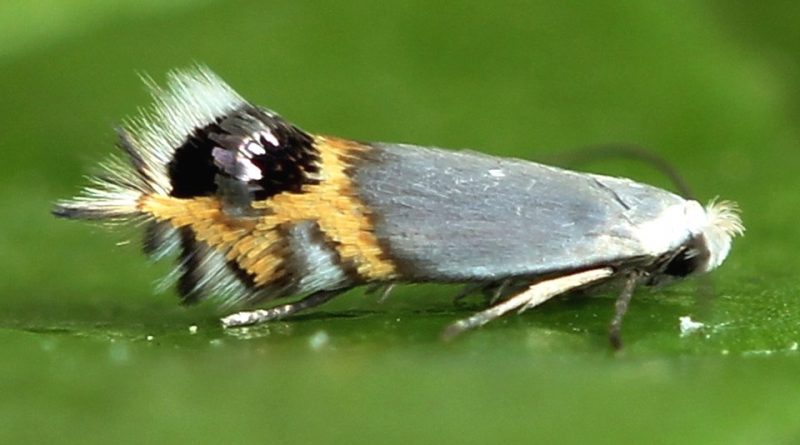Leucoptera malifoliella
Leucoptera malifoliella
The Pear leaf blister moth (Leucoptera malifoliella (O. Costa, 1836)) is a lepidopteran insect belonging to the family of the Lyonetiidae.
Systematic –
From a systematic point of view, it belongs to the Eukaryota Domain, Animalia Kingdom, Sub-Kingdom Eumetazoa, Superphylum Protostomia, Phylum Arthropoda, Subphylum Tracheata, Superclasse Hexapoda, Classe Insecta, Subclass Pterygota, Cohort Endopterygota, Superorder Oligoneoptera, Lepidopid family, Order Panorididea, to the genus Leucoptera and to the species L. malifoliella.
The terms are synonymous:
– Elachista malifoliella Costa, 1836;
– Opostega scitella Zeller, 1839;
– Cemiostoma scitellum (Zeller, 1839);
– Leucoptera scitella (Zeller, 1839).
Geographical Distribution and Habitat –
Leucoptera malifoliella is a moth widespread throughout Europe, up to the limit of the coldest north areas, and its larvae feed on Alnus incana, Amelanchier ovalis, Aronia, Betula pendula, Betula pubescens, Chaenomeles japonica, Cotoneaster integerrimus, Crataegus crus- roosters, Crataegus monogyna, Cydonia oblonga, Malus baccata, Malus domestica, Malus floribunda, Malus floribunda Prunus avium, Prunus cerasus, Prunus domestica, Prunus fruticosa, Prunus insititia, Prunus spinosa, Prunus subhirtella, Pyrus communucis and Sorb.
Morphology –
The Pear leaf blister moth, in the adult state, is a small butterfly with 6-8 mm wingspan.
The front wings are silvery light gray with irregular patterns, placed in the distal part, yellow-orange and black, with frayed edges.
The larvae are endophyte, therefore they live in the leaf mesophyll, and are recognized because they are yellow-greenish in color and about 3-4 mm long.
The eggs are whitish and generally found glued to the underside of the leaves.
Aptitude and biological cycle –
The Leucoptera malifoliella is a small butterfly that winters at the chrysalis stage, in a whitish cocoon with a shape similar to the letter H, on the trunk of the host plants and, more rarely, on the fruits in stock. In spring, generally in April, it appears in the adult state and lays eggs on the lower layer of the leaves.
The larvae, born from the first generation, are active until mid-May. In June the 2nd generation begins, with a peak of maximum presence of adults in the third decade of the month. In July-August there is a 3rd generation with larvae present at the end of the month; these larvae will give rise to the 4th generation in late summer.
The larvae of this latest generation become incriminated and overwintered. On average in Italy this moth turns 4 generations; however in particular climatic conditions the generations can go down to 2-3 or go up to 5.
The larvae live by nibbling the inside of the leaves, digging concentric tunnels, with a diameter of 5 to 6 mm, form whitish spots first and then darker, in which we can see for transparency the excrements gathered in darker concentric circles.
At the end of their growth, they come out of the tunnel and weave a cocoon, on the surface of the leaf (first generation), or in the cracks of the bark on the lower layer of the gills, rather than in the peduncular and pistillary cavities of the fruits, characteristic of the second generation.
At the end of the cycle, after the adults flicker, the empty leaf mines necrotize with consequent phylloptosis.
Ecological role –
The Pear leaf blister moth is a small leaf miner moth active on some plants such as above all the Apple tree and more rarely the Pear, the Cherry, the Quince, the Birch and others.
The main damage is in the leaves where the larvae develop in the mesophyll, digging characteristic spiral tunnels with concentric circles which, in conditions of high infestation, can cause severe phylloptosis.
The proliferation of this butterfly, like other phytophagous insects, derives mainly from the excessive specialization of crops, from the indiscriminate use of pesticides, which alter the faunal and floristic biocoenoses, from the use of fertilizers that alter the physiology of the plants (such as the excess nitrogen fertilizers), etc.
For this reason, careful preliminary planning of interest-bearing plants and conditions that could facilitate the increase in the population of this butterfly is important.
However, if the infestation occurs, chemical interventions can be used, but with great caution, by implementing guided struggle criteria based on environmental monitoring through sampling or with sexual traps that verify the moment of the flicker.
The intervention must safeguard the natural enemies of this moth, especially the Eulophid Hymenoptera, parasitoids of the larvae that are attacked inside the mines.
In the case of sampling, a certain number of leaves are chosen, taken from the orchard at medium height, and the eggs, larvae and mines present are counted on them; the intervention thresholds are:
– 1st generation: 20-30% of leaves with eggs, or 20 mines per 100 leaves with live larvae;
– 2nd generation: 15-20% of leaves with eggs, or 20 mines with live larvae on 100 leaves;
– 3rd generation: 10 mines with live larvae on 100 leaves. We intervene with growth regulators or chitin development inhibitors that can be applied even at the beginning of flights.
In the case of monitoring with sexual traps, the intervention method is as follows:
– the traps must be installed in the orchard at the end of March in a number of 1-2 per hectare or per plot, according to the type of farm;
– the intervention thresholds are highly variable depending on the environment, the generations and the varieties considered. The catches are only indicative for maximum oviposition flicker peaks.
In some cases, thresholds of 400 first generation adults caught per trap per week justify intervention against the second generation.
Guido Bissanti
Sources
– Wikipedia, the free encyclopedia.
– Russo G., 1976. Agricultural entomology. Special Part. Liguori Editore, Naples.
– Tremblay E., 1997. Applied entomology. Liguori Editore, Naples.

